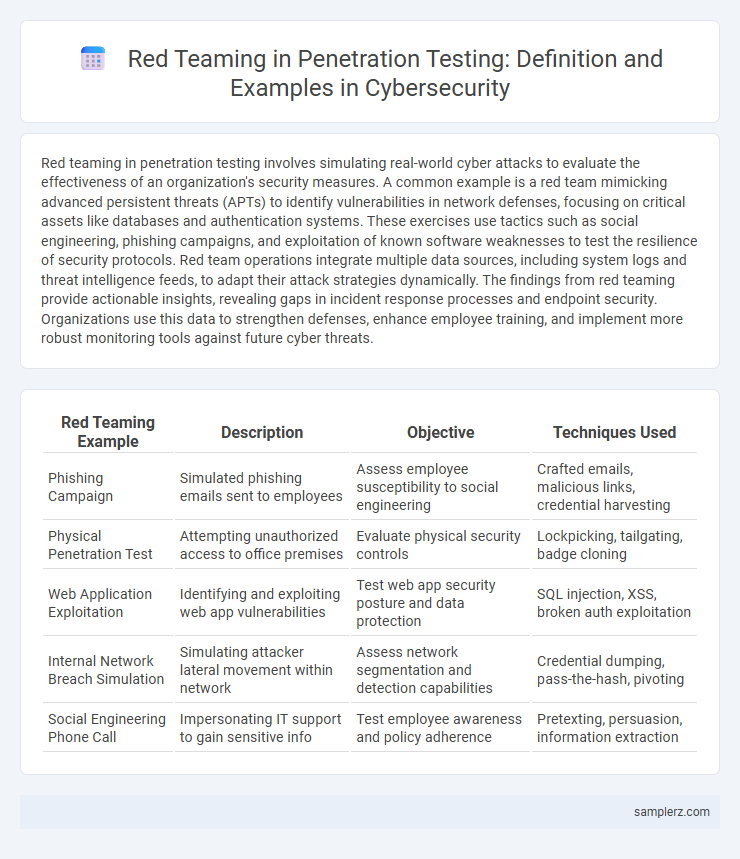Red teaming in penetration testing involves simulating real-world cyber attacks to evaluate the effectiveness of an organization's security measures. A common example is a red team mimicking advanced persistent threats (APTs) to identify vulnerabilities in network defenses, focusing on critical assets like databases and authentication systems. These exercises use tactics such as social engineering, phishing campaigns, and exploitation of known software weaknesses to test the resilience of security protocols. Red team operations integrate multiple data sources, including system logs and threat intelligence feeds, to adapt their attack strategies dynamically. The findings from red teaming provide actionable insights, revealing gaps in incident response processes and endpoint security. Organizations use this data to strengthen defenses, enhance employee training, and implement more robust monitoring tools against future cyber threats.
Table of Comparison
| Red Teaming Example | Description | Objective | Techniques Used |
|---|---|---|---|
| Phishing Campaign | Simulated phishing emails sent to employees | Assess employee susceptibility to social engineering | Crafted emails, malicious links, credential harvesting |
| Physical Penetration Test | Attempting unauthorized access to office premises | Evaluate physical security controls | Lockpicking, tailgating, badge cloning |
| Web Application Exploitation | Identifying and exploiting web app vulnerabilities | Test web app security posture and data protection | SQL injection, XSS, broken auth exploitation |
| Internal Network Breach Simulation | Simulating attacker lateral movement within network | Assess network segmentation and detection capabilities | Credential dumping, pass-the-hash, pivoting |
| Social Engineering Phone Call | Impersonating IT support to gain sensitive info | Test employee awareness and policy adherence | Pretexting, persuasion, information extraction |
Real-World Scenarios: Red Teaming in Action
Red teaming in penetration testing involves simulating real-world cyberattacks to evaluate an organization's security posture against advanced persistent threats. By mimicking adversaries' tactics, techniques, and procedures (TTPs), red teams help identify vulnerabilities in networks, systems, and human factors under realistic attack conditions. This approach provides actionable insights for improving incident response, threat detection, and overall cybersecurity resilience.
Simulated Attacks: Red Team Penetration Test Case Studies
Red team penetration testing involves simulated attacks that mimic real-world threat actors to evaluate an organization's security posture. Case studies reveal scenarios such as spear-phishing campaigns, physical security breaches, and network exploitation techniques used to identify vulnerabilities. These controlled simulations provide actionable insights for strengthening defenses against advanced persistent threats (APT) and insider risks.
Breaching the Perimeter: Physical Security Red Team Examples
Red teaming in penetration testing exposes vulnerabilities by simulating adversarial attacks on physical security controls such as access badges, surveillance blind spots, and unguarded entry points. Examples include tailgating employees to bypass badge authentication, manipulating security cameras, and exploiting poorly secured doors to gain unauthorized building access. These tactics reveal weaknesses in perimeter defense, prompting organizations to strengthen physical barriers and enhance monitoring protocols.
Social Engineering in Red Team Engagements
Red teaming in penetration testing often involves social engineering tactics to exploit human vulnerabilities within an organization. Techniques such as phishing, pretexting, and baiting simulate real-world attacks to assess employees' susceptibility to manipulation and unauthorized access. Effective red team engagements provide critical insights into security awareness gaps and help strengthen an organization's overall defense strategy against social engineering threats.
Bypassing Controls: Network Red Team Operations
Network red team operations simulate adversary tactics to bypass layered security controls such as firewalls, intrusion detection systems, and network segmentation. Techniques include exploiting zero-day vulnerabilities, crafting obfuscated payloads, and leveraging compromised credentials to achieve lateral movement within the network. These exercises provide actionable insights into gaps in detection and response capabilities, enhancing overall security posture.
Advanced Persistent Threat (APT) Simulation by Red Teams
Red teaming in penetration testing involves emulating Advanced Persistent Threats (APTs) to assess an organization's security posture against sophisticated, long-term cyber attacks. These simulations include stealthy network infiltration, lateral movement, and data exfiltration techniques used by nation-state actors. Performing APT simulations helps identify vulnerabilities in detection, response, and resilience strategies, enabling targeted improvements in cybersecurity defenses.
Insider Threat Emulation: Red Teaming from Within
Insider Threat Emulation in red teaming involves simulating attacks from within an organization to uncover vulnerabilities that external assessments might miss. Red teams mimic malicious insiders by exploiting restricted access, escalating privileges, and manipulating internal systems to test detection and response capabilities. This approach provides critical insights into the effectiveness of internal security controls and employee awareness against threats originating from trusted users.
Cloud Infrastructure Red Team Testing Examples
Red teaming in cloud infrastructure penetration testing involves simulating real-world cyberattacks targeting cloud-based assets such as AWS, Azure, or Google Cloud environments. Examples include exploiting misconfigured identity and access management policies, abusing exposed API endpoints, and leveraging privilege escalation vulnerabilities within container orchestration platforms like Kubernetes. These realistic attack simulations help organizations identify security gaps and enhance their cloud defense mechanisms against sophisticated adversaries.
Reporting and Lessons Learned from Red Team Exercises
Red teaming in penetration testing involves simulating realistic cyber-attacks to identify vulnerabilities within an organization's defenses. The reporting phase delivers detailed, actionable insights on exploited weaknesses, attack pathways, and compromised assets, enabling tailored remediation strategies. Lessons learned from red team exercises highlight gaps in security controls, improve incident response protocols, and enhance overall organizational resilience against real-world threats.
Metrics for Measuring Red Team Penetration Success
Red team penetration testing success is measured by metrics such as the percentage of critical vulnerabilities identified, the time taken to breach defenses, and the effectiveness of evasion techniques used during simulated attacks. Key performance indicators include the number of high-severity security gaps exploited, the level of access achieved within the network, and the detection rate of red team activities by blue team defenders. Tracking post-engagement remediation rates and improvements in incident response times further quantifies the impact of red teaming exercises on overall organizational security posture.

example of red teaming in penetration testing Infographic
 samplerz.com
samplerz.com